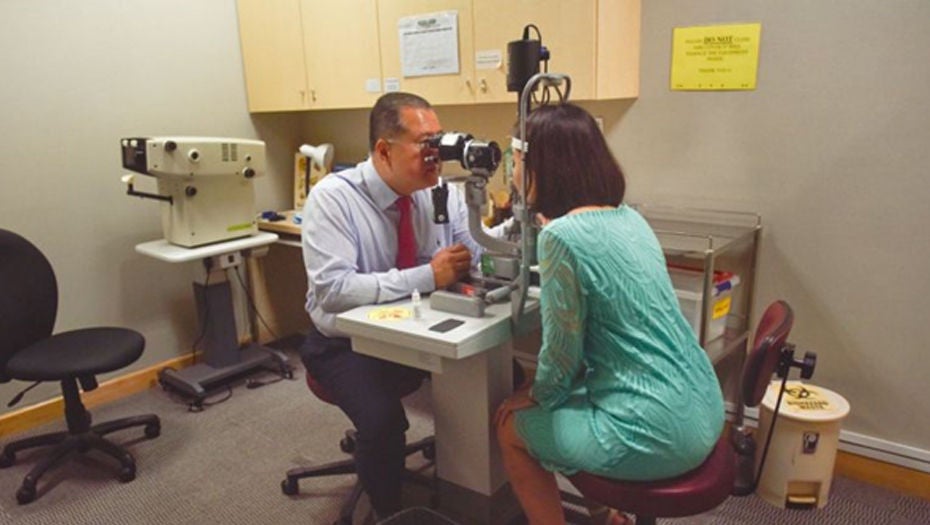
Professor Aung Tin, Singapore Eye Research Institute's executive director, conducting a mock eye examination. While overseas studies have found a link between myopia and glaucoma, it is the first time this link has been found in Singapore.ST PHOTO: JASMINE CHOONG
SINGAPORE - Singaporeans with myopia have a higher chance of getting glaucoma when they grow older and the risk increases as myopia becomes more severe, according to the results of local studies revealed on Thursday (Oct 4).
Three separate studies spanning 10 years were conducted on 711 Chinese patients (2013 to 2014), 104 Malay patients (2004 to 2006) and 46 Indian patients (2007 to 2009) by the Singapore Eye Research Institute (Seri) and Singapore National Eye Centre (SNEC).
While overseas studies have found a link between myopia and glaucoma, it is the first time this link has been found here, according to Professor Aung Tin, Seri's executive director and a researcher involved in the studies.
Researchers found that patients across the three racial groups had a similar risk of developing glaucoma, which can lead to blindness due a build-up of pressure in the eye causing damage to the optic nerve.
It affects around 3 per cent of people over 40 here and the risk increases with age.
Chinese Singaporeans with moderate myopia - 300 to 600 degrees - were five times more likely to have glaucoma than those without myopia, while Malays were three times more likely to develop it.
For Chinese with severe myopia - more than 600 degrees - they were 15 times more likely to suffer from glaucoma. Indians with moderate to severe myopia were two times more likely to develop it.
However, Chinese with mild myopia - less than 300 degrees - were only two times more likely to get glaucoma.
In addition, Chinese with a family history of glaucoma were nearly eight times more likely to develop it later in life.
Prof Aung said that while researchers have yet to establish the reason for the link between myopia and glaucoma, the discovery shows that people should take preventive measures.
"We suspect that when you have very high myopia, your eyeball becomes stretched and the tissue supporting the nerve in the eye is weaker so you are at more risk of eye pressure," he said, adding that reduced blood flow in highly myopic eyes could be another reason.
Singapore has the world's highest prevalence of myopia, or short-sightedness, among seven to nine-year-olds.
Prof Aung, a senior consultant at the SNEC's Glaucoma Department, said myopia prevention starts with children and that lifestyle, environmental and behavioural factors should be tackled.
For example, a previous study found that a lack of outdoor activity is a risk factor for myopia progression in children.
Other risk factors for glaucoma include far-sightedness, usage of steroid medication and having sustained an eye injury.
Glaucoma patient Mr Wong, 62, who declined to give his full name, has had myopia since he was in secondary school.
It stabilised at 375 degrees in his 20s and he was diagnosed with glaucoma around 30 years ago.
"Due to my tunnel and limited field vision, I can only focus on one object at any one time," said the retiree, who is blind in his right eye and has very low vision in his left. "Hence, I tend to lose my bearing and orientation easily."
To cope, he walks slowly in public places and stops briefly when unsure of the path ahead. A regular runner who also does half-marathons, Mr Wong admits that he sometimes trips or crashes into barriers but tries to keep to the route by following the runner in front.
SOURCE: THE STRAITS TIMES SINGAPORE PRESS HOLDINGS LIMITED. REPRODUCED WITH PERMISSION.













 Get it on Google Play
Get it on Google Play